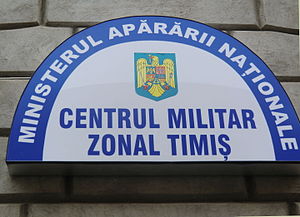Military Hospital for Trauma Surgery Dr. Victor Popescu
| Military Hospital for Trauma Surgery Dr. Victor Popescu | |
|---|---|
| Sponsorship | Romanian Army (Romanian: Armata Română ) |
| place | Timișoara |
| state | Timiș County |
| Country | Romania |
| Coordinates | 45 ° 45 '25 " N , 21 ° 13' 31" E |
| surgeon | Mircea Calculates |
| beds | 300 |
| areas of expertise | Trauma surgery |
| founding | 1754 |
| Website | Spitalul Militar de Urgență Timișoara |
The military hospital for trauma surgery Dr. Victor Popescu ( Romanian Spitalul Militar de Urgență Dr. Victor Popescu , popularly military hospital ) was built in 1754 by the Habsburg military administration in Timisoara , the capital of the Temescher Banat crown domain . Today the Military Hospital for Trauma Surgery in Timișoara on Strada Gheorghe Lazăr, number 7, is one of the most modern hospitals in the Romanian Army .
history
Habsburg era
Building history
The beginnings of the military hospital in Timisoara go back to the imperial army , which liberated the fortress from Turkish rule in 1718. Until 1753 there was no separate civil and military medical service. The Mercy Hospital and the City Citizens Hospital were responsible for all residents of the city, including the military. In 1753 the civil administration separated from the military administration and the army needed its own hospital. The military hospital was completed in 1754.
Initially, the hospital was only one story. But it soon turned out that the capacities of the newly built hospital were no longer up to the requirements. The first application to increase the military hospital was rejected by Vienna for financial reasons . Only after the Congress of Vienna , when Austria found itself in calmer waters, was the increase approved in 1816. To keep the financial burden within limits, a financial plan was drawn up for three years. In 1817, 80 bricklayers and carpenters were brought to the Banat from Bohemia . The recommendation was made that the newcomers should be paid two thirds of the local salary, as well as housing, clothing and medical care. In 1819 21 masons and 14 carpenters were added. For the year 1816 150.000 crowns were provided for in 1817 there were 100,000, for the year 1818 still 95,000 and for 1819 only 50,000 crowns . The construction was completed in 1821.
Medical history
The Austrian army was familiar with the latest medical care findings of the time. The military units had well-trained medical personnel. In 1817 a battalion of 2,800 soldiers had a senior physician and two junior physicians. The surgeon and military - surgeons were well trained, the doctors had a degree from the University of Vienna . A medical brochure by Giovanni Alessandro Brambilla was distributed free of charge to the military doctors for further training of the doctors . The military doctors gradually introduced the first vaccinations against leafing after the vaccination had already been successfully carried out in Bohemia. Likewise, were prophylactic measures to prevent introduced to disease, such as against scurvy .
From 1790 the hospital struggled with financial problems. In 1805 many medicines were canceled or replaced by surogates . The situation was similar with the food in the hospital kitchen. In 1807, when there was no more wheat flour, it was replaced by oat flour. The cultivation of vegetables in the barracks yard and along the fortress wall was ordered so that the kitchens could be supplied with vegetables. Then there were the unsatisfactory hygienic conditions. The in-hospital mortality rate was 2.5%. In 1820, 40 out of 1649 patients died in the hospital.
post war period
In August 1944, the military hospital was converted into a hospital for Company 517. Until 1945 the military hospital also had a department for wounded prisoners of war. In the period 1948–1958, a third of the hospital was occupied by a Soviet anti- aircraft company. In 1959 the military hospital had a capacity of 300 beds.
1969–1973 the first university clinic for internal medicine and the first surgical university clinic in Timişoara were set up in the military hospital under the direction of Professors Ana Aslan and Ion Făgărăşanu . Here, Doctor Pius Brânzeu laid the foundation for vascular surgery . Equipping the hospital with modern technical equipment has been a top priority since 1992.
Today the "Military Hospital for Trauma Surgery Dr. Victor Popescu ”among the most modern hospitals in the Romanian Army.
The hospital has eleven departments: surgery , intensive care , orthopedics , ear, nose and throat medicine , internal medicine , cardiovascular diseases , neurology , psychiatry , infectious diseases , skin and sexually transmitted diseases .
See also
literature
- Thomas Breier: The history of medicine Temeswars 1718–1990. Schrobenhausen 2003
- Else von Schuster: A tour of Timisoara. O plimbare prin Timisoara, ADZ-Verlag, 1996
Web links
- www.smutm.ro ( Memento from October 22, 2013 in the Internet Archive ), website of the Military Hospital for Trauma Surgery Dr. Victor Popescu

